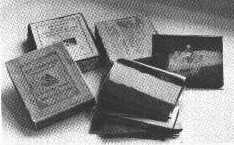
All of these first systems had one major drawback. They had to be carried
out immediately. This meant that the photographer had to carry not only
a supply of the heavy and fragile glass plates but also all of the sensitizing
and developing equipment along with a portable dark room or dark tent with
him where ever he went to take photographs.
The arrival of the Dry Gelatin Plate process in 1877 by Dr. Richard
L Maddox rendered all these early messy processes obsolete.
An emulsion of gelatin and silver salt was spread on a glass plate
and allowed to dry. When dry these plates could be stored (in the dark)
and used as needed which meant that the photographer only needed to take
his camera and a supply of plates with him.
By 1880 quite a lot of companies both in Europe and America started
manufacturing these dry plates.
In Europe there were companies such as Agfa in Germany and Ilford
in
England and in America the Eastman Dry Plate Company which later became
known as Kodak and later Polaroid.